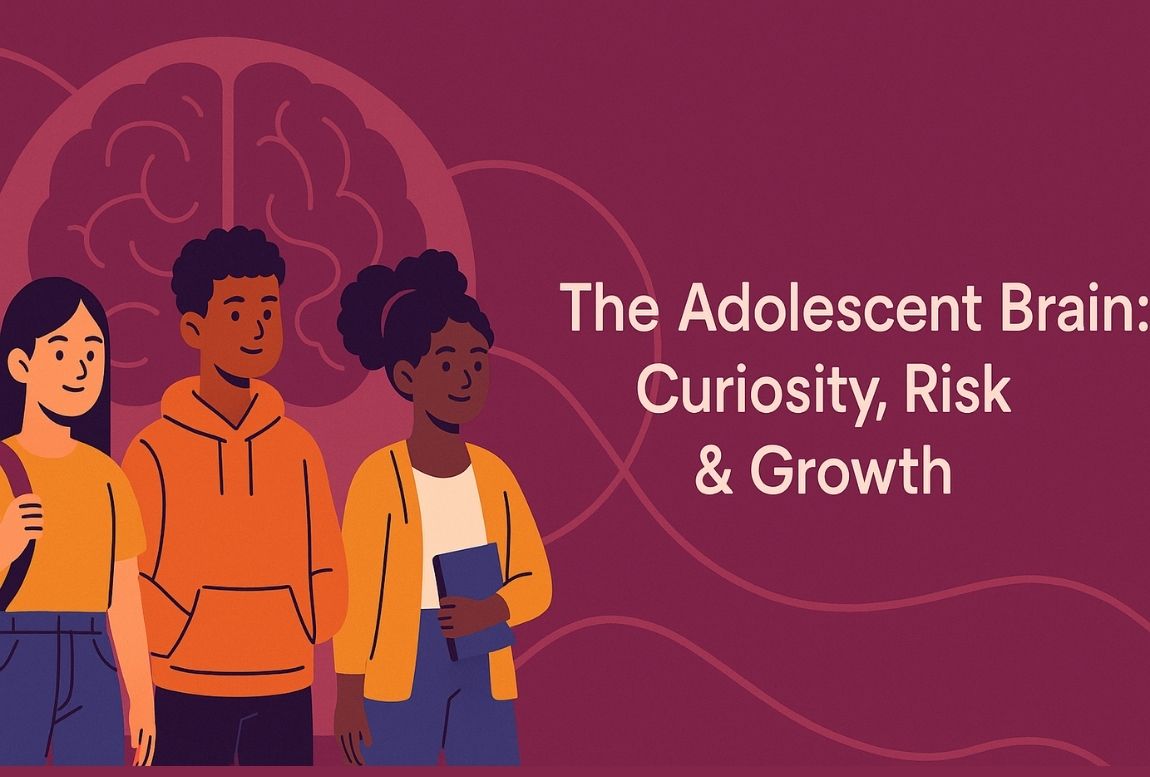The Adolescent Brain: Why Risk-Taking and Curiosity Go Together

Imagine you’re 15 and someone says: “Hey, let’s try this trick on the skateboard you’ve never done before!” You feel nervous, excited, a little scared but you do it anyway. At the same time, you’re asking yourself lots of questions: “What happens if I fall? What happens if I succeed? What if I don’t try?” That mix of “let’s see what happens” + “I wonder how far I can go” is very common for teens.
That happens because the brain of a teenager is doing two big jobs: learning how to be an adult, and testing what it can do. This blog will walk you through why curiosity and risk go side by side during the teen years, what is really behind it, and how teens and grown-ups can help make the best of it.
What Happens Inside the Teen Brain
As kids move into their teen years, parts of their brain change a lot. One part that handles feelings, excitement, rewards gets strong early. Another part that helps think ahead and control impulses matures later. Because of this, teens feel “Wow!” when they try something new; their thinking part may still say “Wait, what about the cost?” but the “wow” part often wins first.
Also, when something’s unknown—“I haven’t done this before, I’m not sure what will happen” teens often tolerate that unknown better than younger kids or even some adults. That means more willingness to experiment.
Curiosity and Risk: Two Sides of the Same Coin
- Curiosity is like a flashlight shining into new places. You think: What if I try this? What if that happens?
- Risk-taking is when you step into those new places even though you don’t know exactly how it will turn out.
- For teens, these two go together because everything is “first time”: first love, first big idea, first job, first driving, etc.
- The good news: this means great opportunities to learn, grow, and find new strengths. The challenge: sometimes, the risk is too big or the support is too little.
- When adults see a teen doing something “risky,” it might help to ask: Is this new experience + learning? Or is it an avoidable danger?
Why Teens Are Especially Wired for This
- Teens are building identity: Who am I? What am I good at? What do I care about? Trying new things helps answer these.
- Peer presence amplifies things: when friends are around, everything feels more thrilling, more meaningful. Developing Adolescent+1
- Some research shows that for teens, the “unknown result” aspect is more comfortable than for many adults. They will try something even if they don’t know how likely it is to succeed. PMC
- This doesn’t mean teens are reckless by nature, it means they’re in a phase of exploration. And exploration can be positive if channeled well.
What Healthy Exploration Looks Like
Here are signs that a teen’s exploring in a good way, rather than heading into uncontrolled risk:
- The teen is trying something new (club, hobby, sport, volunteer work) and reflecting on how it went.
- There’s support or guidance: someone showing interest, checking in, being available.
- The teen is safe: equipment works, plan is sound, choices are understood.
- The teen learns from the experience: “That was fun, but next time I’ll do this differently.”
What Adults (Parents/Educators) Can Do?
If you’re a parent or teacher or someone supporting a teen, here are simple ideas:
- Encourage curiosity: Ask “What new thing do you want to try?” instead of only “What are you doing wrong?”
- Open about risk: Don’t just say “No, don’t do that.” Instead ask: “What do you think could happen? What would you do if…?” That helps the teen think.
- Build safe zones: Create opportunities for trying new things in supervised or low-risk spaces (e.g., hiking with friends, art project, safe driving course).
- Talk about mistakes: Let the teen know it’s okay to fail or to change plans. That’s how we learn.
- Balance freedom + check-in: Youth need space, but they also need to know someone cares. A quick “How did it go?” can make a difference.
7. When to Be Alert
Most of the time, curiosity + risk can be part of healthy growth. But here are warning signs:
- The teen repeats dangerous behaviour without learning or changing
- The risk involves harmful substances, self-harm, or serious accidents
- The teen says they “can’t stop” doing something risky and it scares you
- You sense the teen is hiding things rather than talking about them
In these cases, getting extra support and help can make things safer.
Support and Guidance
If you feel like this phase is more scary than exciting, you might consider support from someone who understands teen brains and behaviour. For example, a structured program designed for parents and teens can help channel curiosity and risk into growth.
Conclusion
Teens are not “out of control.” They are learning, growing, and trying to understand the world in their own way. Their brain mixes curiosity with trying new things, and sometimes that can look risky. But with gentle guidance, open talks, and the right support, this phase can help them build confidence and find who they really are.
If you’re a parent or a teen and you feel things are getting confusing, stressful, or a bit too much, you don’t have to figure it all out by yourself. Sometimes a simple conversation with someone who understands teen behaviour can make everything feel lighter and clearer.
SoulNirvana offers a safe, friendly space for teens and families to talk, understand, and grow together. If you ever feel the need for support, you can gently reach out. We're here to help, not judge.
Book a session now.
FAQs
Q1. Why do teens do things adults would never dream of?
A: Because their brain is wired to try new things while the thinking-ahead part is still maturing. It’s normal to feel bold, curious, and a bit anxious.
Q2. How can I tell if the risk is “good” or “bad”?
A: A “good” risk is something new, with some thinking behind it. A “bad” risk is something that keeps happening and seems dangerous without purpose.
Q3. What can a parent say instead of “Don’t do that”?
A: “I know you’re curious—tell me what you’re thinking. What might happen? What would you do differently next time?” This invites conversation.
Q4. When should we ask for extra help?
A: If the teen is repeating harmful behaviour, is hiding things, or you notice emotional or mental health signs slipping. It’s okay to ask for professional help.
References
- Defoe, I.N., & Romer, D. “Adolescents’ own views on their risk behaviors…” Frontiers in Psychology, 2022. PMC
- “Adolescents’ risk-taking behavior is driven by tolerance to ambiguity.” PMC. PMC
- “The Science Behind Adolescent Risk Taking and Exploration.” UCLA Developing Adolescent. Developing Adolescent
- “Risky Teen Behavior Is Driven by an Imbalance in Brain Development.” Scientific American. Scientific American
- “Curiosity in childhood and adolescence.” ScienceDirect. sciencedirect.com

Ms Sonali Sikdar
Ms Sonali empowers individuals to grow, heal, and align their careers with their inner calling.
Related Blogs
No related blogs available.
